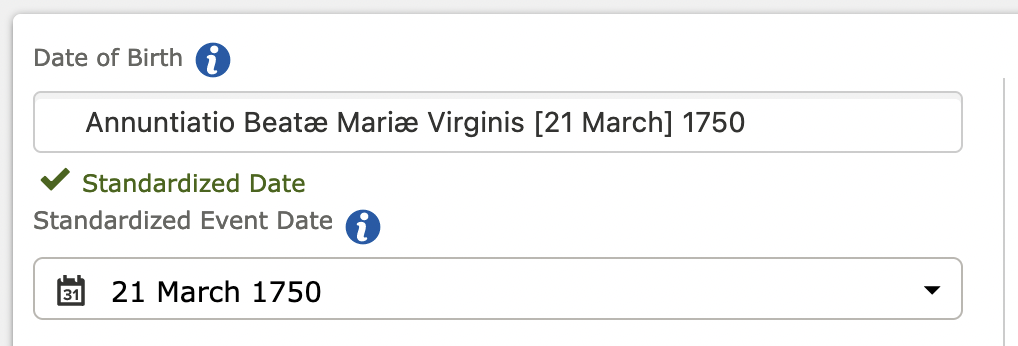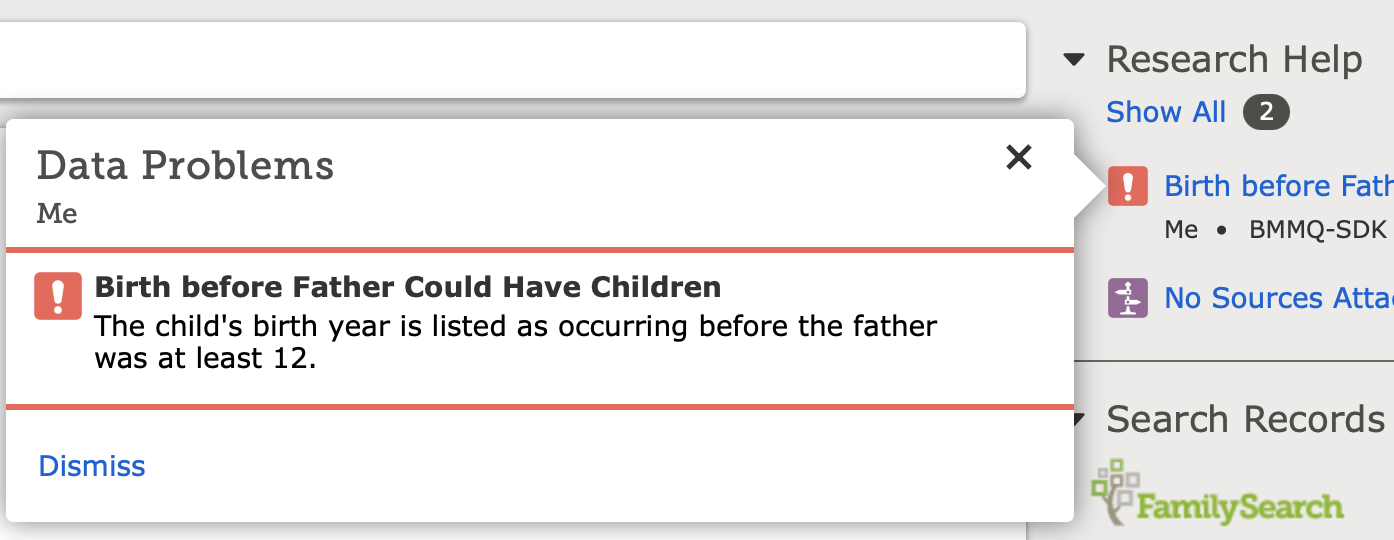A bunch of suggestiosn - My wish list
Suggestions for new or improved features
1) No person can have more than two biological parents.
2) Dates of birth and death for parents and children must be temporally possible. No child born before its parents were born or after its parents died.
3) Search for Find A Grave sources by memorial number.
4) Import from Find A Grave more often than every six to twelve months.
5) GEDCOM imports do not go directly to the tree. They must be matched against existing people. See WikiTree. In fact, I would not mind if GEDCOM imports were banned.
6) Import cemeteries from Find A Grave.
7) "View My Relationship" can be told to ignore connections through a certain person, or to specifically include a specific person.
8) "View My Relationship" can include more than one relationship path.
9) Show relationship between any two arbitrary people. Show all relationships if more than one exists. It looks like some of this is available in a third-party web site (BYU) Relative Finder.
10) Sources labeled as NFT are readable by ordinary people.
11) More possible relationships to parents ... Godparent, Foster, Sponsor
12) "View My Relationship" can include or exclude relationships that are not biological. Adopted nieces and nephews, for example.
13) Date ranges can be specified as "between" or "from - to". These two forms have different meanings.
14) Dates can be specified in combined Julian and Gregorian notation, such as "4 January 1588/9". Right now this is nt cosidered a "standardized" date format.
15) The output of "View My Relationship" should be printable.
Comments
-
@WilliamGee , It’s generally best to put only one suggestion in a post. It is easier for a discussion to develop.
1) There can be more than two differences of opinion as to who is a biological parent.
2) A child can certainly be born after a parent’s death.
6) What do you mean by, “Import cemeteries from Find A Grave?” You can now manually enter grave location. Do you mean some kind of automatic process. IMO this would not be good because FAG has some gravesite errors.
10) Source viewing is controlled by the collection owner. FS attempts to allow viewing for all when possible.
1 -
Dates and places can be entered in what ever format they need to be entered in. "Standardized" means "linked to an appropriate equivalent for data processing purposes." It does not mean "you have to enter data in one and only one way."
All of dates below are correctly standardized and follow FamilySearch guidelines for data entry
13) All routines for searching and such are so fuzzy in how they handle dates that the programming will not handle between and to/from ranges any differently. To be precise for other researchers who do see the difference, enter "between ... and ..." like this:
which displays as:
It would be nice to have the Between construction as a standard just to have the choice there. Both options should show in the drop down menu when either are typed in just to have people think about the difference.
14) Nothing really needs to be changed. One of the beauties of Family Tree is the flexibility we have in displaying data. All these work just fine:
These are all correctly standardized and correctly entered. There are so many possible ways that may be needed to most accurately enter dates to prevent any confusion, that this double entry of Display/Standard data is one of the best features of Family Tree. You can enter combined Julian/Gregorian dates exactly as you need them displayed and then decide what you want the computer to use for calculations:
1 -
OK, good point on child born after a father's death. But no more than nine months! I often - OFTEN - see children born many years after both parents died, or years before parents were born. That is biologically impossible, and I think the application should prevent it.
It would be a substantial effort to write the program to handle it. How to deal with merges? GEDCOM imports (which are the source of many problems)? How to deal with inexact dates such as when only the year is known? How to deal with cases where no dates are known? Not an easy programming task.
Note that I only asked for birth date checking related to birth and death. I also often see children born when either or both of their parents were 6 or 7 or 8 years old. Also biologically impossible, but for programming an application where do you set that cutoff? It is a fuzzy line. It is probably reasonable to assume that age 12 and under is not able to have children, and age 16 and over is able. But that is not always true. Likewise, any female who has a child after about age 45 is automatically suspect. But that is not a hard/fast date. I have seen children listed with a mother who was 83 years old. That is clearly impossible, but what about 50? or 52? Uncommon, but it has happened.
It is also a biological fact that no person can have more than two biological parents. This, I think, should be reflected in the application. It would be a programming task even more difficult than checking age of parents, but I think possibly more important. I see people with multiple sets of biological parents even more often than with parents out of the age range.
If multiple parent sets are given, then only one can be biological. The rest are step-parents, or adoptive, or foster, or god-parents, or bad data. But not biological. There is already a feature to mark other parent-child relationships which probably does not get used often enough.
As for dates - OK, they can be entered as plain strings in dang near any format anyone can think of. How do they get used in calculations? I think that Family Search does almost no calculations on dates. Perhaps if no calculations are done, then there is no need for a "standardized" date format. That would present a problem deciding whether a person was born before their parents ...
I have seen cases where a person was listed as born on 3 February 1560 and yet their parent died on 5 February 1559. That is actually possible if the 1560 date is Gregorian and the 1559 date is Julian. But how is a poor schmo like me supposed to figure that out? Maybe the attached sources make it clear. More often there are no attached sources. Perhaps it would help to make more clear that any dates not otherwise labeled are Gregorian.
I think it is incumbent on whoever edits a profile to check that sort of thing, and to make it clear somehow what is really going on.
As for the difference in "between" and "from - to" dates... It is subtle. I regard "between" as dating a single event whose exact date is know to fall between two dates. "From-to" is a state of being that lasts from one date to another. For example ... It is perfectly correct to say that a person was born "Between 1560 Feb 03 and 1560 Mar 03". It is also correct to say that a person bore the nobility title Lord of Shropshire "From 1560 Feb 03 to 1570 Jun 15". But to say a person was born "From 1560 Feb 03 to 1560 Mar 03" implies that the birth process took a month. Another way to say it is that "between" is equivalent to "After 1560 Feb 03 and before 1560 Mar 03". "From-To" is equivalent to "During".
I do like one feature of Family Search date formatting, which is to always use the name of the month. I have been tripped up many times by sources which say something like 1560-02-03. Is that February third or March second?
Import cemeteries from Find A Grave: I have found several cases where a cemetery listed for a Find A Grave memorial does not exist in the place-name database at Family Search. I also see cemeteries which are listed under different names between the two sites. As an example - Find https://www.findagrave.com/cemetery/76084/needham-smith-chapel-cemetery in Family Search's place names. It is not there. The closest I have found is Smith Chapel Cemetery, but it is listed as being within a community in Hardin County. Find A Grave lists the enclosing place as Hardin County, with no reference to a community. So are they the same place?? Damnifiknow! I think they are, but no way to prove it. By importing the cemetery list from Find A Grave, it would be possible to exactly match them up. There are, of course, problems with duplicates. There are also some date issues. Family Search knows, for example, that Kentucky was not in the United States before 1786. Find A Grave has no clue about how place names change over time.
Bill Gee
0 -
Two (or more) sets of biological parents happen every time I do a merge session. Every. Time. Yes, eventually they get cleaned up, but until then, the very last thing I need is the program yelling at me about it. Merging is tedious and annoying enough as it is.
The system already has flags for mismatched or impossible ages/dates. No, this doesn't prevent them from being entered, but this is exactly as it should be: it may very well be the parent's data that's wrong, not the child's that you're trying to enter -- or vice versa. Anything more than a flag would prevent corrections unless they were done in a very specific sequence, and that is not a desirable situation at all.
4 -
@WilliamGee , your quote "It is also a biological fact that no person can have more than two biological parents." My objection to that is that there can be more that two "Opinions" about who the biological parents are thus requiring the ability of attaching more than one set of biological parents.
0 -
"I think that Family Search does almost no calculations on dates. Perhaps if no calculations are done, then there is no need for a "standardized" date format. That would present a problem deciding whether a person was born before their parents ..."
They do a lot of calculations on dates. That is why we see the data errors based on dates. It is the standard date that is used in calculations. But what is great with Family is that we can enter a complete, unambiguous, fully labeled date in any format imaginable according the needs of a particular profile and along with that enter the exact but sometimes too limited date we want the program to use for calculations. That is the philosophy behind the double data entry of Displayed Date and Standard Date.
The program currently performs calculations on dates to check for the data errors listed here: https://www.familysearch.org/en/help/helpcenter/article/what-are-all-the-possible-data-problems-in-family-tree
I won't repeat all 23 of them here. These cover pretty well #2 on your wish list. They are flagged as errors just as soon as Save is clicked.
If your #2 is actually a request to check for one of these errors before Save is clicked or after Save is clicked but before the data is actually saved, say with a pop-up that says "Cannot save date - Would show person died before marriage," that would be a new feature. It could, however, lead to a situation where one is prevented from saving a correct date because some other date on the person or on a spouse, parent, or child of that person is wrong.
"Note that I only asked for birth date checking related to birth and death. I also often see children born when either or both of their parents were 6 or 7 or 8 years old. Also biologically impossible, but for programming an application where do you set that cutoff? It is a fuzzy line. It is probably reasonable to assume that age 12 and under is not able to have children, and age 16 and over is able. But that is not always true. Likewise, any female who has a child after about age 45 is automatically suspect. But that is not a hard/fast date. I have seen children listed with a mother who was 83 years old. That is clearly impossible, but what about 50? or 52? Uncommon, but it has happened."
In the article I referenced above the definition for each of the errors checked for is listed. Also, the error flag defines the error right there on the profile page like this:
Most of these date data problems are dismiss-able by clicking on "Dismiss" for those situations where an unlikely but not impossible event occurred, such as a 60 year old woman having a child.
1








